A dandelion bug soda starter culture is a probiotic fermentation of the dandelion root, which can be used to make delicious, fizzy homemade sodas.
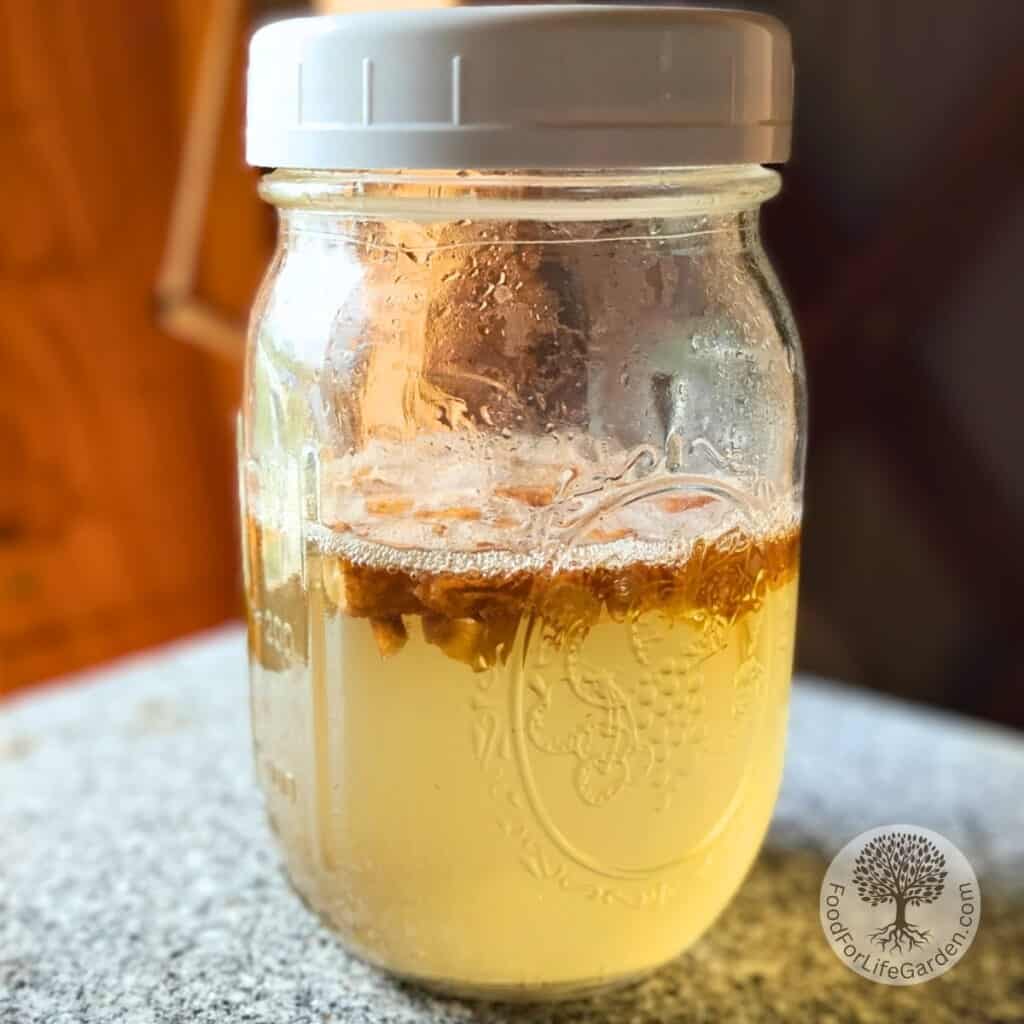
This post contains affiliate links, which means I make a small commission at no extra cost to you if you click through and make a purchase. See my full disclosure here.
Maybe you have heard of using ginger rhizomes to make a ginger bug. Well, you can make a similar starter culture using dandelion roots. Dandelion roots are everywhere and grow naturally, probably in your backyard. Dandelions are packed with health benefits from flowers to root. If you need to do some weeding, save a few dandelion roots, wash them well and let’s make a dandelion bug for your next home-brewed fizzy batch of sodas!
Use this dandelion bug to make delicious sodas, such as home brewed ginger beer, a naturally carbonated hibiscus soda, fizzy lemonade soda and other flavored sodas. You can also make a ginger bug soda starter culture if you have easy access to ginger.
Why Make A Dandelion Bug?

I love using my girl ginger, the ginger bug for homemade sodas, but frankly, it can get expensive to feed her if I need to buy the fresh ginger. And organic ginger is not available where I live. I do grow some of my own ginger too, but I don’t have a big window to keep a bunch of pots for growing plants inside in the winter. My yurt has just one window and I have a big shelf in front of it, because it’s crammed in here and I need to use every bit of space to store my stuff.
So I have been thinking about using local resources to make a starter culture bug with something that’s free and grows wild. The best candidate in my opinion is dandelion root. It grows everywhere, is abundant and sometimes it grows in spots where I prefer not to have it.
That is why I started using dandelion root for my soda starter bug and she’s working out really nice so far. I decided to name her because she’s proving herself capable of doing her job here and is welcome to stay. Y’all, welcome Ms. Dandy Lion to the soda making department at Food for Life Garden!
Healthy And Useful Dandelion Root
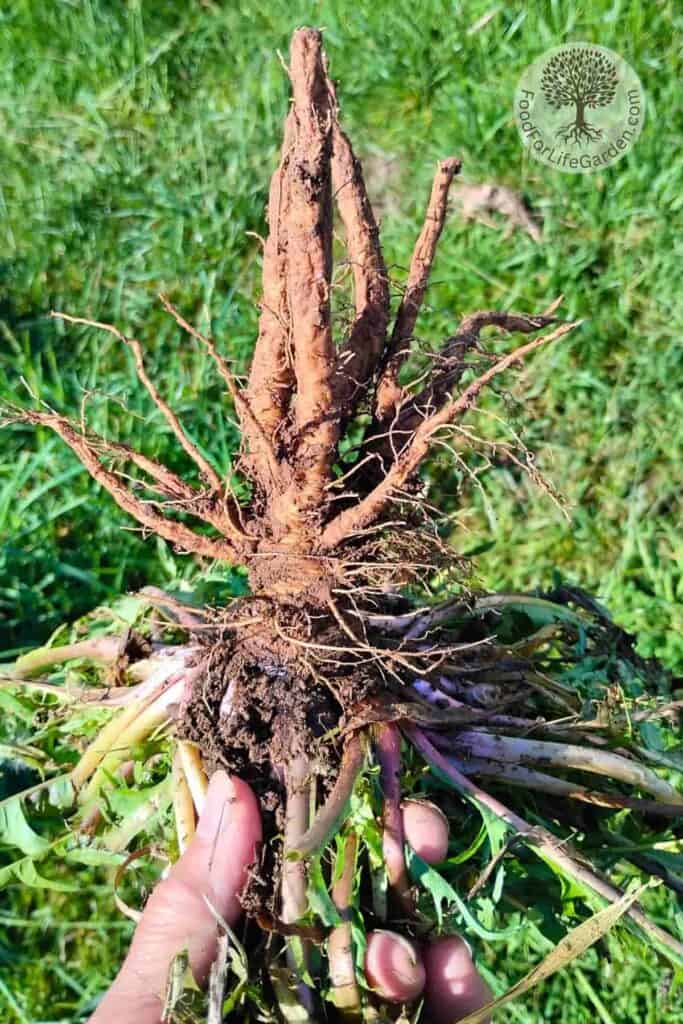
I probably don’t have to tell you that the dandelion has a ton of health benefits. All parts of the plant can be used and I hope to do a detailed post about the benefits of dandelion and the many ways it can be used.
Dandelion root is famous for making a liver-supporting coffee substitute when roasted, similar as chicory root. The root gets roasted and ground into a powder that tastes a bit like coffee and is great if you want to cut down on your caffeine intake.
As an avid coffee drinker, I drink my fair share of the brew each day, but don’t like the hyperness that comes with having so much caffeine. So I mix half real coffee grains and half chicory or dandelion root granules in my percolator to get a super flavorful coffee that tastes better than straight coffee in my opinion, and I consume less caffeine. That’s a win-win!
So let’s make more use of the awesome dandelion root with today’s recipe:
How To Make A Dandelion Root Bug
For now though, we’ll make an awesome starter culture that we can use to make naturally carbonated sodas. You’ll be able to use it for making fizzy lemonade, fruit juice sodas, and carbonating teas. If you’re so inclined, you can even use it to start a batch of wine. But we will not get into this today, that’s for later. Today we’ll make a lively, fizzy dandelion bug. Let’s get to the recipe.
Equipment
A pint sized glass jar with a lid
Ingredients
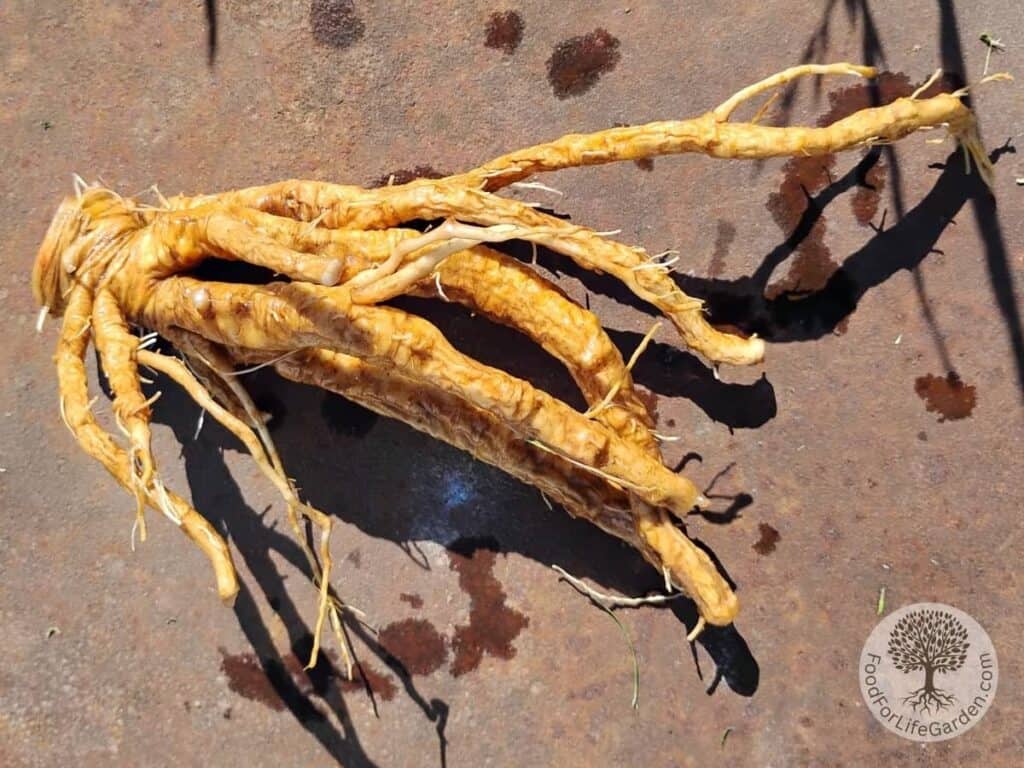
Dandelion Root – Pick your roots from an area that you know is free of pesticides and away from roadsides, power lines, gas pipelines, or other maintained areas. City parks are probably not a good idea. Wash it well and if necessary lightly scrub. Do not peel. Then chop into thin slices.
Organic cane sugar – Great choices are evaporated cane juice granules, sucanat (panela sugar), or coconut sugar.
Do not use sulfured molasses, the sulfur will kill your fermentation critters. Honey is highly anti-microbial and is not a good choice for creating a starter. It can be used later in making soda, but for your starter culture it is best to use granulated sugar.
Filtered or well water – Chlorine in water kills the microbes that we need, so don’t use straight tap water or chlorinated well water. I don’t have water installed here, so I use either trucked in well water or rain water that I filter through my Berkey water filter.
Instructions for Making A Dandelion Bug Starter Culture
Day One
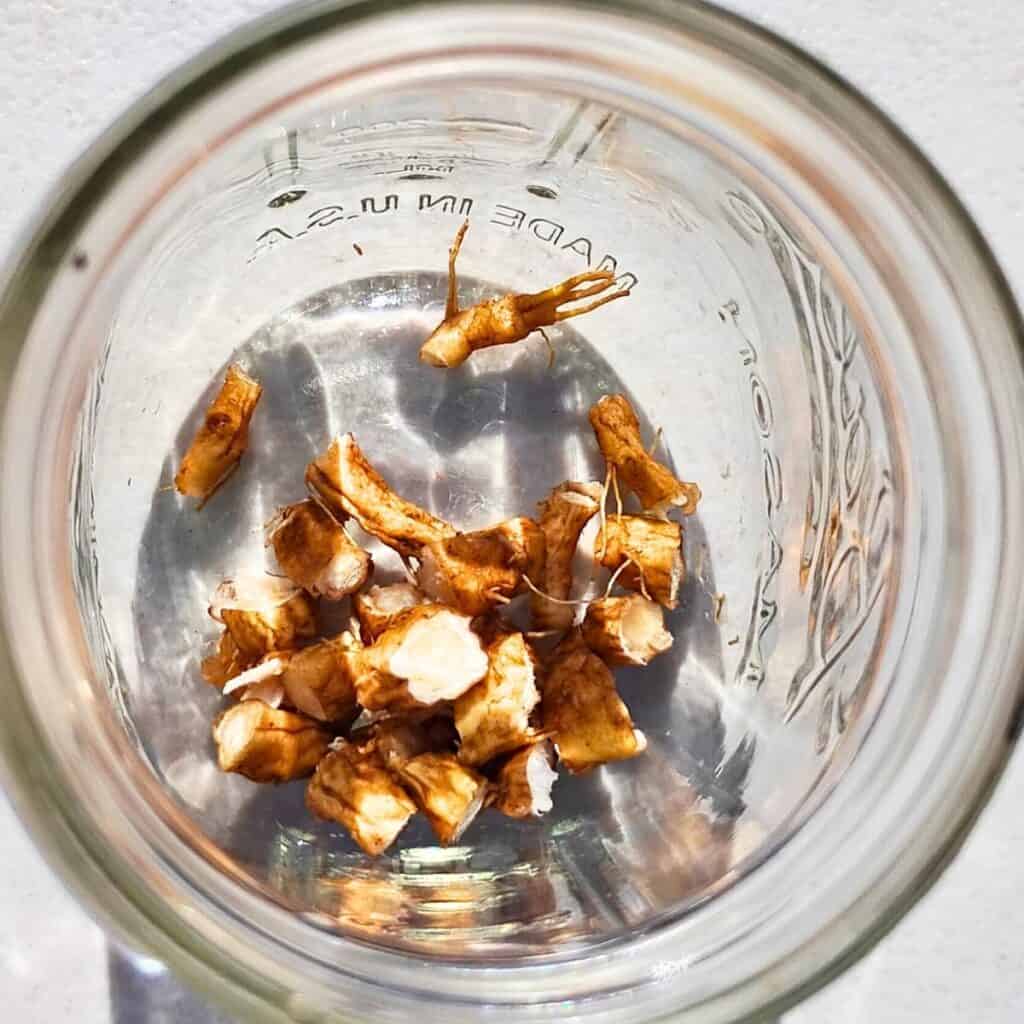
Add 1-2 tablespoons of chopped dandelion root to the glass jar.
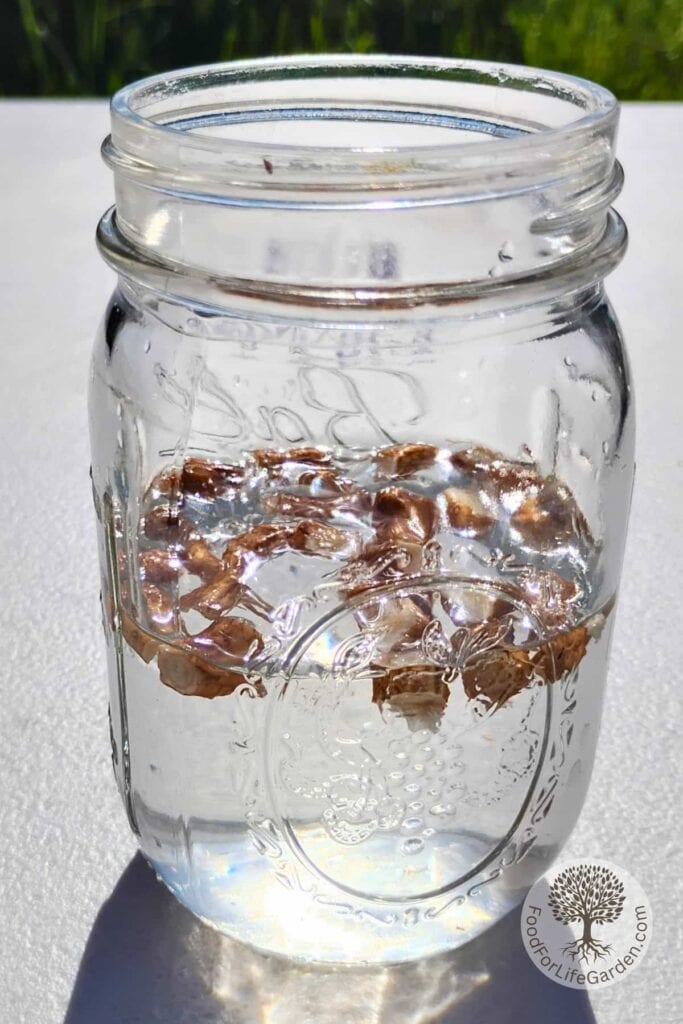
Pour 1 cup of filtered water over the ingredients
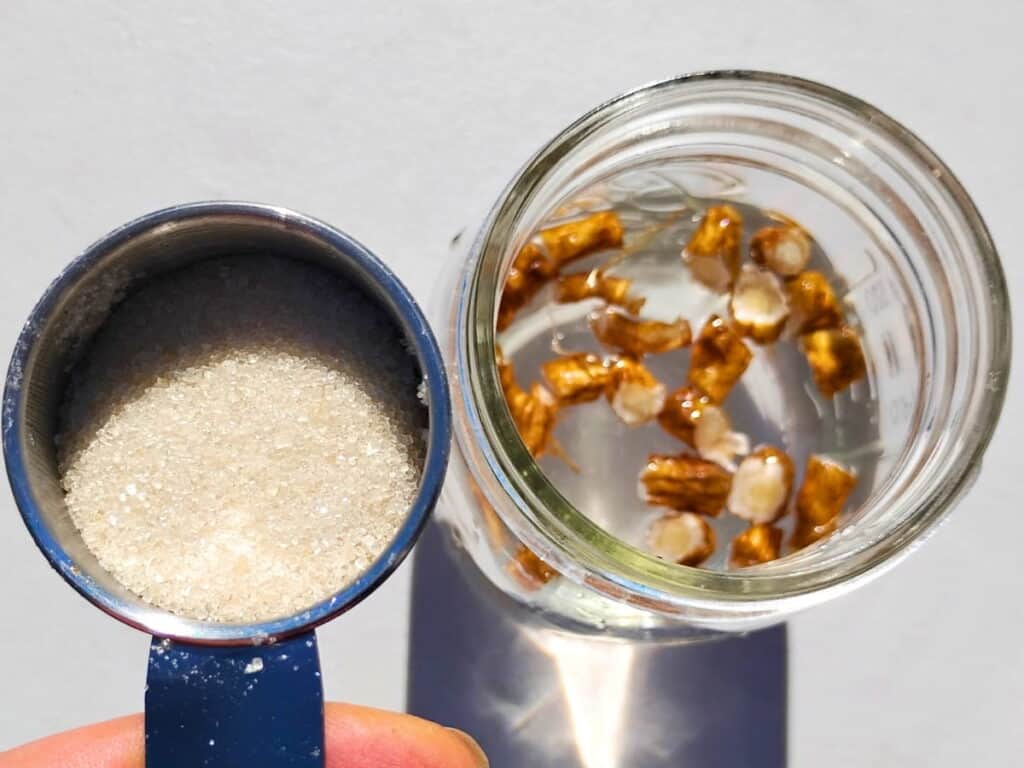
Add 1 tablespoon of sugar.
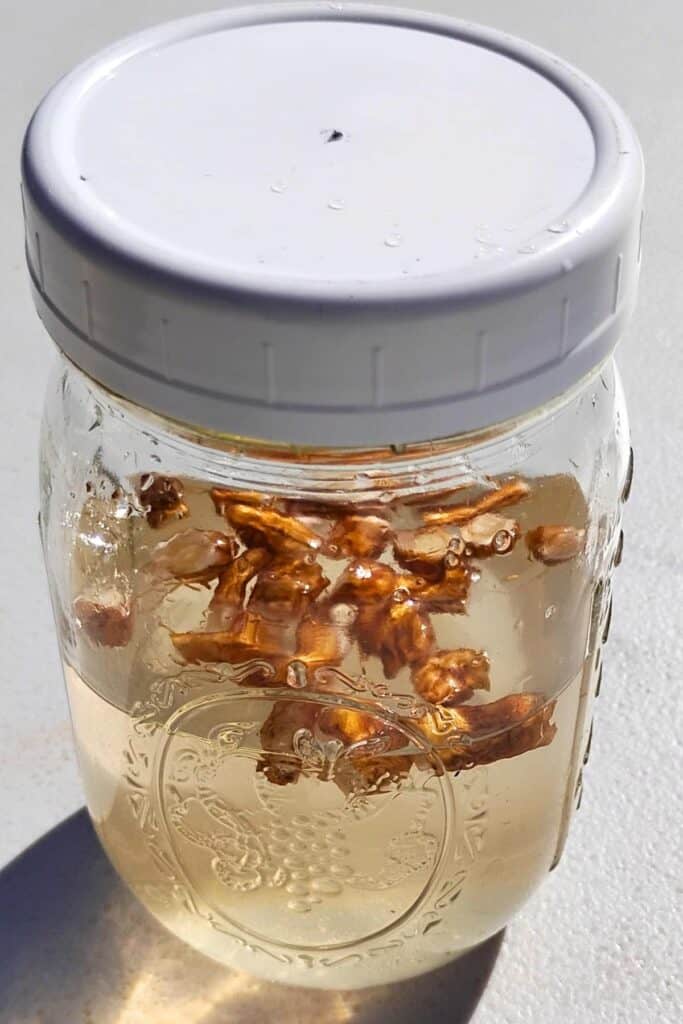
Stir well to dissolve the sugar and screw the cap on fingertight.
Set the jar out of sunlight in a warm place (70-80 degrees is ideal)
Day Two
Now you’ll do your first bug feeding:
Add 1 teaspoon of chopped dandelion root
Add 1 teaspoon of sugar
Stir well, recap, and place somewhere out of direct sunlight
Day Three and onward
Feed the bug just the same as on day two.
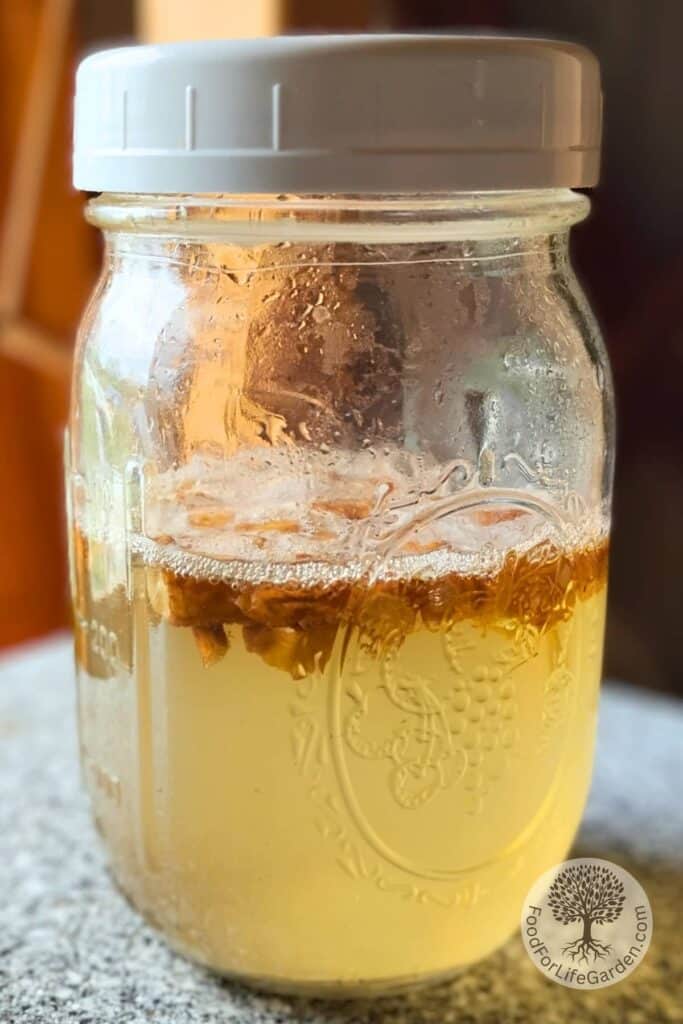
By now you should see some bubbling and a difference in the scent of the bug.
Observe your starter culture. It should show some lively bubbling, look cloudy, and smell ‘fermented’. This can happen anywhere between 2 and 7 days.
When is it ready to make soda?
You can try to make soda once your dandelion bug is vigorously bubbling away. Sometimes it’s fizzy in 3 days, but if you’re not in too much of a hurry, I would wait till day 5 before you use it as a starter culture. Sometimes it can take a week, if your environment is on the cool side.
Maintenance
Keep feeding your new dandelion root starter culture once every day or two while you keep it on the counter. If you want to use it, remove what you need and replace the water, add one teaspoon of the dandelion root and one teaspoon of sugar. You’ll have to remove some of the dandelion root pieces occasionally when your jar has too many in it. But otherwise this is all the maintenance your dandelion starter needs.
If you want to take a break from using the bug, you can store it in the refrigerator after feeding. You can keep it in the refrigerator for a long time, but take it out occasionally, once every two weeks to a month, to give it a feeding. This will keep it healthy. I like to take my bugs out for a few days every so often just to regenerate them. But they will normally be fine even for several months without feeding or warming.
How To Use Your Dandelion Bug
This dandelion bug is a starter culture that will put fizzy carbonation into your drinks. It can be used the same as a ginger bug in recipes.
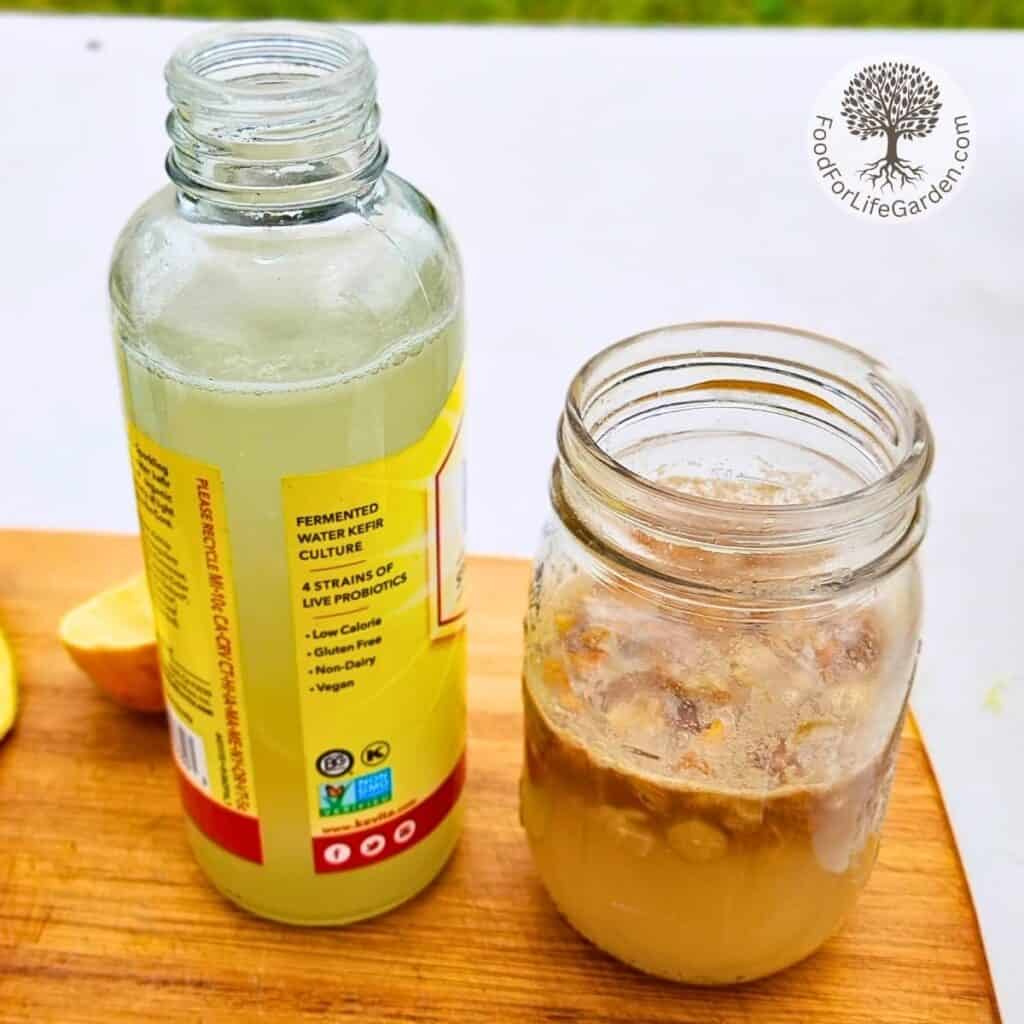
Basically you can add about 2 tablespoons of the starter and some sugar to a pint of any liquid and seal it tight. I very much recommend grolsch type bottles with flip-tops for this. They are best at sealing in the carbon dioxide so your soda develops some fizz.
Let it sit at room temperature for 2-3 days. This is when the probiotic bacteria and yeasts multiply and feed on the sugars in the drink. They eat the sugars and produce lactic acid, and carbon dioxide as a by-product. A very small amount of alcohol is also produced, about as much as you get from ripe fruit or yeast bread.
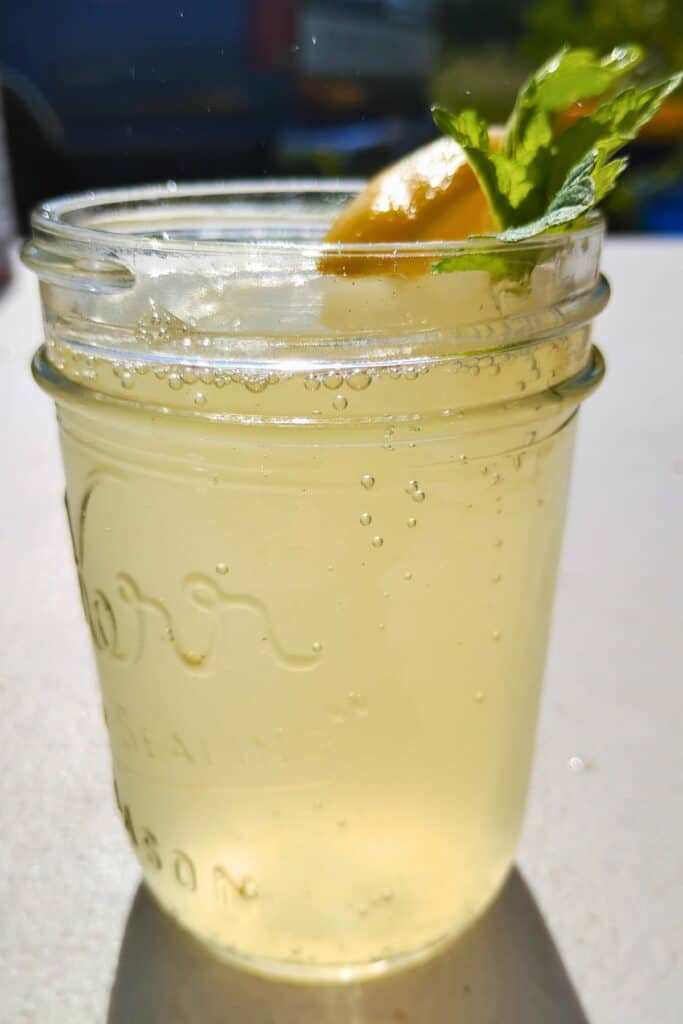
This results in a less sweet soda that’s full of probiotic activity. Just the thing you want to feed your gut. And in the process you get a super refreshing fizz in your drink.
Cautions:
Do burp your bottles once a day to release some pressure. It is possible for the bottles to explode if pressure builds up too high. So just to be on the safe side, open your bottles quickly to let a little of the fizz out and close them back up. Press down on the lid while opening.
Probiotic sodas are considered non-alcoholic, but they have in fact a very low percentage of alcohol. Generally under 1 percent, which is no more than you find in yeast breads or very ripe fruit. They do have the potential for higher alcohol content if you add more than a tablespoon of sugar per pint of soda and let it ferment longer. This turns your soda basically into wine. The trick is to keep your sugar content on the low side and to refrigerate your soda once it has enough fizz. Refrigeration will almost stop the fermentation and the development of more alcohol.
Making Soda From Juice Or Tea
To make your own soda, follow the instructions for fermented lemonade. For various flavor options, replace the lemon and water with your choice liquid, such as fruit juices. I would dilute them with a little with water and omit adding extra sugar if they are very sweet.
You can also use any kind of black, green or herbal tea. I highly recommend you try hibiscus tea soda, it’s super delicious and a great summer drink.
Another possibility is to blend some fruits or infuse whole berries in water, add sugar and starter in a vented mason jar. Don’t close the lid too tight, so gasses can escape. Now wait till it all starts to bubble. Then strain out the berries or pulp and pour the liquid into a fermentation bottle for a final ferment to build up the fizz, which should only take another day or two.
About Making Root Beer
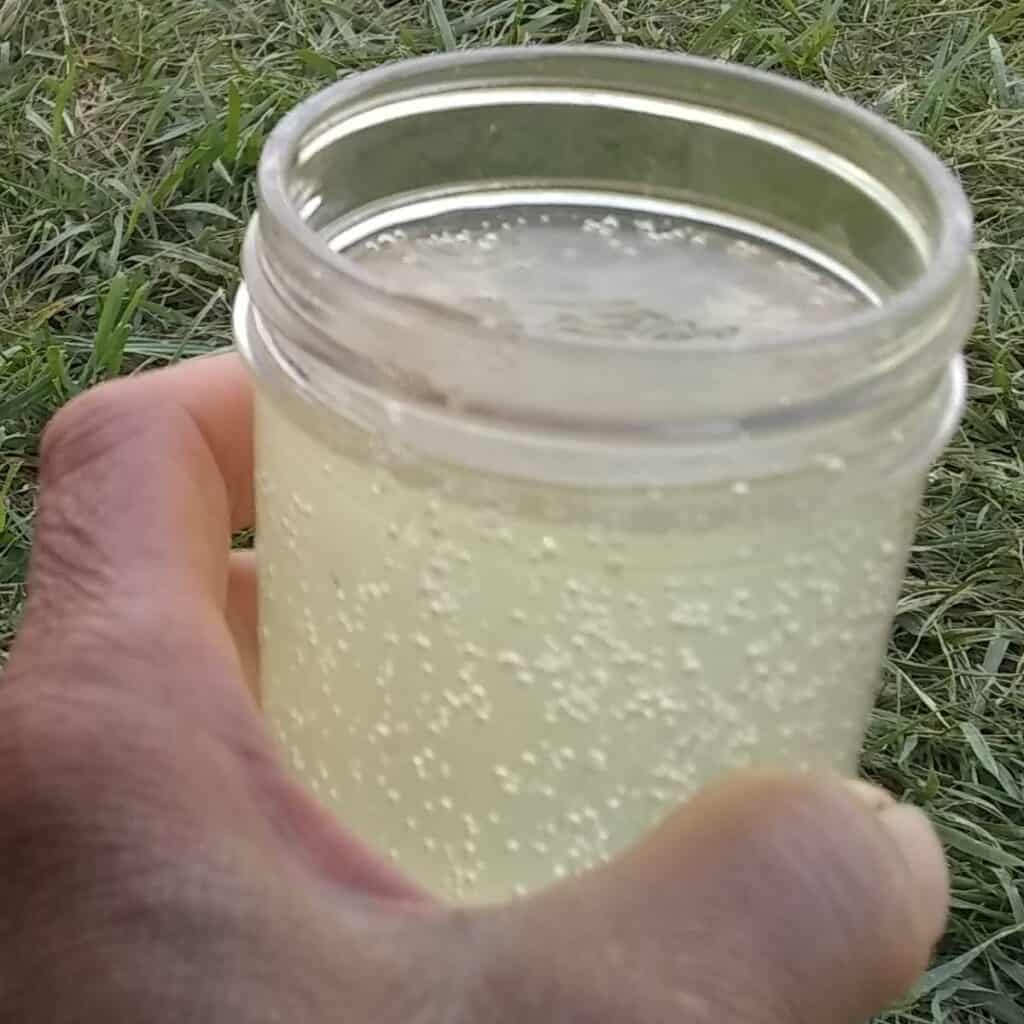
If you are thinking of making a root beer, turmeric, or ginger beer, you’ll want to prepare a simple syrup made by simmering the roots, rhizomes, or barks in water with some sugar (about 1-4 tablespoon per pint of liquid depending on your preference).
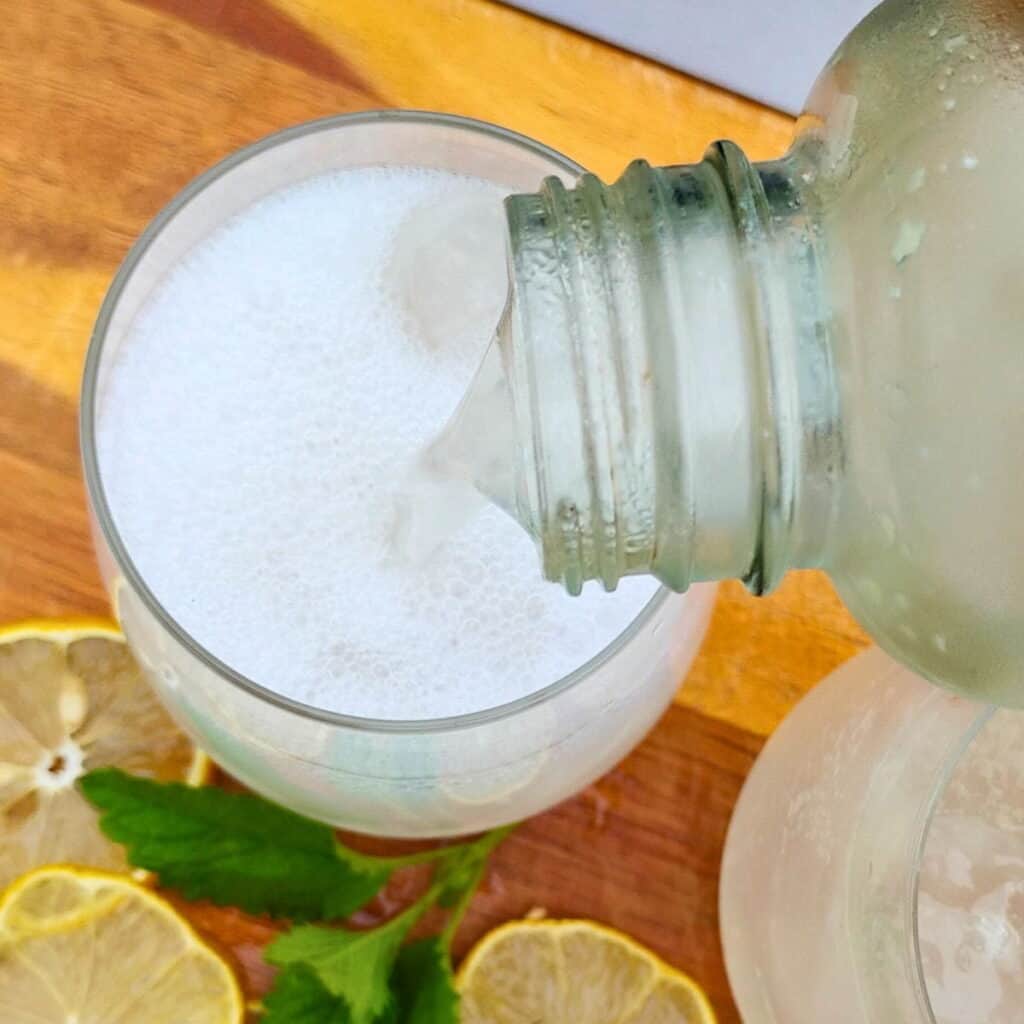
For precise instructions, follow my recipe for ginger beer and in place of the ginger, use the roots or bark and seasonings of your choice in the syrup.
Traditional Root and Bark Choices
- Ginger
- Turmeric
- Sarsaparilla
- Sassafras
- Dandelion root
- Birch bark
- Licorice
- Burdock root
- Chicory root
- Wild cherry bark
- Pine bark and pine needles
The Root Beer Dilemma
Traditionally sarsaparilla and sassafras were the main ingredients to make root beer along with some other flavorings. But the FDA deemed sassafras unsafe due to some lab results that showed liver damage in rats after injecting them with large quantities of safrole, an active constituent in sassafras.
This ingredient can also be found in nutmeg, cinnamon and other herbs. As a result of the lab study, the FDA required all root beer manufacturers to stop using sassafras in root beer. So they they started using wintergreen or artificial flavoring instead (is this going to be better for our liver?).
Just for comparison, for the human equivalent of the amount of safrole that was fed to the rats, we’d have to consume 32 twelve ounce bottles of root beer per day. Besides that, injecting this isolated compound is really not at all like taking the whole herb by mouth. Another one of those unfortunate interventions that are based on overreaction, like is so often the case, while artificial food colorings, PFAs, harmful pesticides and other harmful additives are still FDA approved and in circulation.
My opinion: artificial ingredients are unlikely to be healthier for us, and in my opinion it is unlikely that one or two root beers a day, which contain sassafras, would cause problems. But consider yourself warned, and if you want to make a traditional root beer, be sure to do your own research! There are many recipes for root beer flavorings, here is one by the Happy Recipe Box!
Other root beer ideas, using a simmered syrup
I like combinations like ginger and turmeric with pepper and sometimes I add some dried cayenne peppers too for a nicely spicy drink.
Burdock root was very popular for root beer in England.
Dandelion root is often added to root beer combination brews as well.
Birch bark and wild cherry bark used to be very popular many decades ago.
These are not roots, but you could also add dried mushrooms to the simmering syrup, or elderberries, which should all be simmered before you use them.
Roots and barks should normally be simmered for most herbal preparations to get more of the benefits extracted.
Your Questions Answered
My Final Thoughts
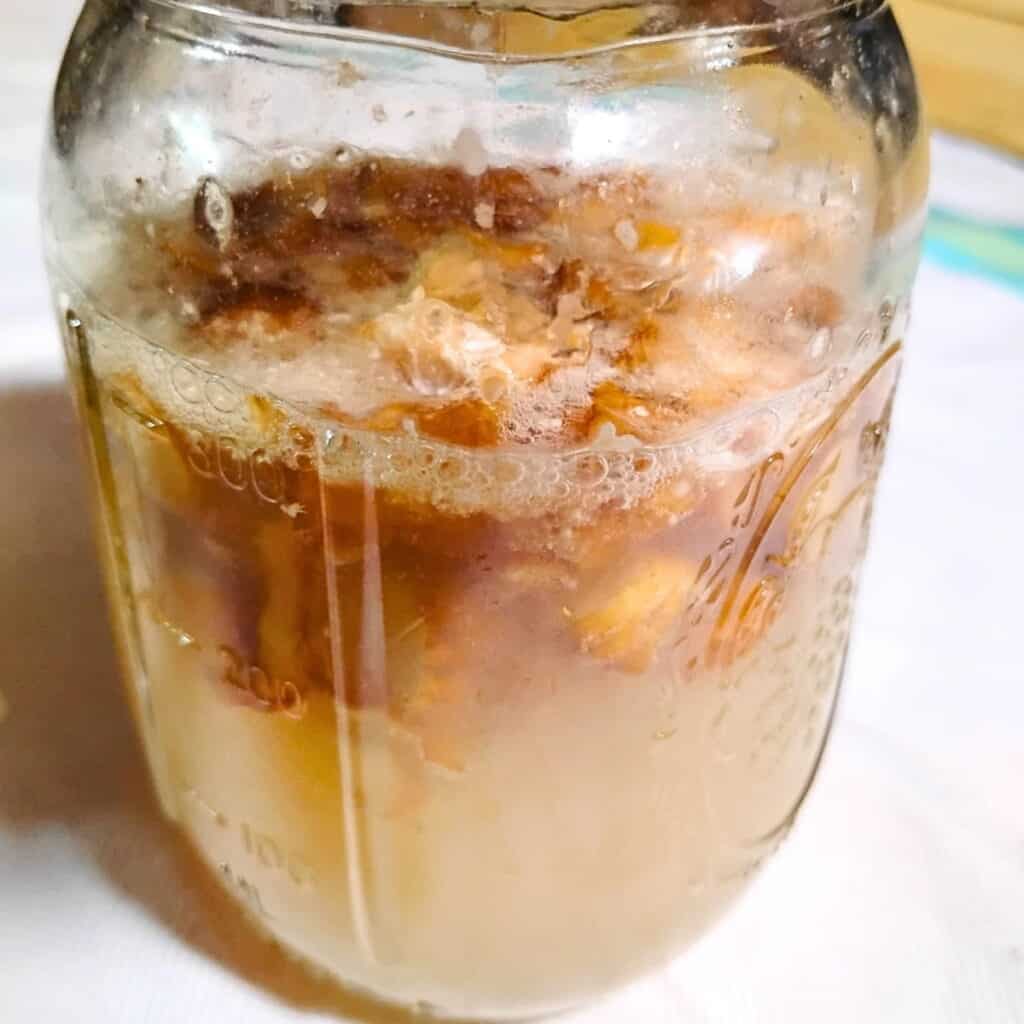
If you followed these instructions, you are looking at a mighty fine, wonderful new critter that can give you years of dedicated service. All you need to do is feed it and keep it happy. Then it will make lots of super delicious sodas for you and your family.
Making your own sodas with your dandelion bug is super rewarding and a hugely superior alternative to commercial sodas. Now you can replace a high sugar, GMO-laden, dead soda that often contains unpronounceable ingredients and artificial colors and flavors.
Instead you’ll enjoy a pleasant, refreshing, less sweet, sparkling soda that is full of probiotics and beneficial microorganisms. These will populate your gut microbiome, improve your gut health, add extra vitamins and minerals, and often health benefits from the ingredients used, such as when making ginger beer or turmeric beer. This to me is a no-brainer. Home brewed fermented sodas, using a probiotic starter such as the dandelion bug, gets my vote in a healthy heartbeat!
If you have any questions, leave me a comment and I’ll do my best to answer quickly. Let me know how it went, if you made this recipe, and how much you love your homemade sodas!
Don’t forget to sign up for more recipes like this as well as homesteading tips and ideas and you’ll get notified by email as I get new information posted!
Other recipes you might like:
Best ginger beer recipe: fizzy, delicious, healthy! Create your own ginger beer from scratch, using ginger bug. Customize with your favorite add-ons.
Naturally carbonated Hibiscus Soda – A beautiful deep red, naturally tangy and refreshing soda that’s full of health benefits and probiotics!
Probiotic Fermented Lemonade Soda – A refreshing fizzy soda that will cool you down on hot days and support your gut health!
Ginger bug recipe puts exciting fizzy sodas on your table! It’s the vital ingredient to making old fashioned home brewed ginger beer that will rock your socks off!
Awesome Uses For Whey – Save the whey! And use it in dozens of ways. You’ll find something to do with whey for every single drop. It’s nutritious, versatile, healthy, and makes great fizzy sodas!
Health benefits of ginger beer Learn all about the awesomeness of ginger. Improve your well being by including ginger in your daily health routine.
Switchel Recipe – A refreshing electrolyte drink for hydration during summer activities.
Healthy Ginger Ale Recipe for a quick refreshing pick-me-up!
Preserved Lemon Confit – Preserving lemons is not just a great way to add storage life to citrus, but it transforms the humble lemon into a delicacy. Great for flavoring beverages too!
How To Grow Ginger At Home – All about growing ginger from start to harvest. Grow it in the garden, greenhouse, or in pots. Plus how to store or preserve ginger, and how to use it.
Shop This Post
Berkey filter
Grolsch type bottles
Evaporated cane juice
Sucanat (Panela sugar, Jaggery)
Coconut sugar
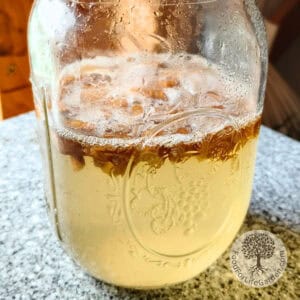
How To Make A Dandelion Bug
Equipment
- 1 pint sized glass jar with a lid I use a mason jar with a simple plastic lid.
Ingredients
- Dandelion Root – Washed well and if necessary lightly scrubbed. unpeeled and sliced thinly
- Organic cane sugar – Great choices are unrefined evaporated cane juice, sucanat (panela sugar), or coconut sugar.
Do not use sulfured molasses, the sulfur will kill your fermentation critters. Honey is highly anti-microbial and is not a good choice for creating a starter.
- Filtered or well water – Chlorine in water kills the microbes that we need so do not use straight tap water or chlorinated well water.
Instructions
Day One:
- Add 1-2 tablespoons of the chopped dandelion root to the glass jar.
- Pour 1 cup of filtered water over the ingredients
- Add 1 tablespoon of sugar.
- Stir well to dissolve the sugar and screw the cap on fingertight.
- Set the jar out of sunlight in a warm place (70-80 degrees is ideal).
Day Two:
- Now you’ll do your first bug feeding:
- Add 1 teaspoon of chopped dandelion root.
- Add 1 teaspoon of sugar.
- Stir well, recap, and set back in to your fermentation corner.
Day Three and onward
- Feed the bug just the same as on day two.
- By now you should see some bubbling and a notice difference in the scent of the bug.
- Observe your starter culture. It should start show some lively bubbling, look cloudy, and smell 'fermented'. This can happen anywhere between day 2 and 7 in most cases.
When is it ready to make soda?
- You can try to make soda once your dandelion bug is vigorously bubbling away. Sometimes it's fizzy in 3 days, but if you're not in too much of a hurry, I would wait till day 5 before you use it as a starter culture, as long as it bubbles vigorously. Sometimes it can take a week, if your environment is on the cool side.
Maintenance
- Keep feeding your new dandelion root starter culture once every day or two while you keep it on the counter. If you want to use it, remove what you need and replace the water, add one teaspoon of the dandelion root and one teaspoon of sugar. You'll have to remove some of the dandelion root pieces occasionally when your jar has too many in it. But otherwise this is all the maintenance your dandelion starter needs.
- Alternatively, when your jar has too many dandelion pieces in it, strain the liquid out into a new jar and give it a regular feeding of 1 teaspoon dandelion root pieces and 1 teaspoon of sugar. Use the pieces in your strainer as a compost accelerator.
- If you want to take a break from using the bug, you can store it in the refrigerator after feeding it. You can keep it in the refrigerator for a long time, but take it out occasionally, once every two weeks to a month, to give it a feeding. This will keep it healthy. I like to take my bugs out for a few days every so often just to regenerate them. But they will normally be fine even for several months without feeding or warming.
Notes
How To Use Your Dandelion Bug
This dandelion bug is a starter culture that will add probiotics and put fizzy carbonation into your drinks. It can be used the same as a ginger bug in recipes. Basically you can add about 2 tablespoons of the starter and 1-4 tablespoons of sugar to a pint of any liquid and seal it tight. If you use fruit juice, you don’t need to add sugar or very little. I very much recommend grolsch type bottles with flip-tops for making sodas. They are best at sealing in the carbon dioxide so your soda develops some fizz. Let it sit at room temperature for 1-3 days. This is when the probiotic bacteria and yeasts multiply and feed on the sugars in the drink. They eat the sugars and produce lactic acid and carbon dioxide as a by-product. A very small amount of alcohol is also produced, about as much as you get from ripe fruit or yeast bread. This results in a less sweet soda that’s full of probiotic activity. Just the thing you want to feed to your gut. And in the process you get a super refreshing fizz in your drink.Cautions:
Do burp your bottles once a day to release some pressure. It is possible for the bottles to explode if pressure builds up too high. So just to be on the safe side, open your bottles quickly to let a little of the fizz out and close them back up. Press down on the lid while opening. Probiotic sodas are considered non-alcoholic, but they have in fact a very low percentage of alcohol. Generally under 1 percent, which is no more than you find in yeast breads or very ripe fruit. They do have the potential for higher alcohol content if you add more than a tablespoon of sugar per pint of soda and let it ferment longer. This turns your soda basically into wine. The trick is to keep your sugar content on the low side and to refrigerate your soda once it has enough fizz. Refrigeration will almost stop the fermentation and the development of more alcohol.Making Soda From Juice Or Tea
To make your own soda, follow the instructions for fermented lemonade. For various flavor options, replace the lemon and water with your choice liquid, such as fruit juices. I would dilute them with a little with water and omit adding extra sugar if they are very sweet.
You can also use any kind of black, green or herbal tea.
Another possibility is to blend some fruits or infuse whole berries in water, add sugar and starter in a vented mason jar. Don’t close the lid too tight, so gasses can escape, or use a fermentation lid. Now wait till it all starts to bubble. Then strain out the berries or pulp and pour the liquid into a fermentation bottle for a final ferment to build up the fizz, which should only take another day or two.
About Making Root Beer
If you are thinking of making a root beer, turmeric, or ginger beer, you’ll want to prepare a simple syrup made by simmering the roots, rhizomes, or barks in water, add some sugar, and stir to dissolve (about 1-4 tablespoon per pint of liquid).
For precise instructions, follow my recipe for ginger beer and in place of the ginger, use the roots or bark and seasonings of your choice in the syrup.
Traditional Root and Bark Choices
- Ginger
- Turmeric
- Sarsaparilla
- Sassafras
- Dandelion root
- Birch bark
- Licorice
- Burdock root
- Chicory root
- Wild cherry bark
- Pine bark and pine needles
Other root beer ideas, using a simmered syrup
I like combinations like ginger and turmeric with pepper and sometimes I add some dried cayenne peppers too for a nicely spicy drink.
Burdock root was very popular for root beer in England.
Dandelion root is often added to root beer combination brews as well.
Birch bark and wild cherry bark used to be very popular many decades ago.
These are not roots, but you could also add dried mushrooms to the simmering syrup, or elderberries, which should all be simmered before you use them.
Roots and barks should normally be simmered for most herbal preparations to get more of the benefits extracted.
Final Thoughts
If you followed these instructions, you are looking at a mighty fine, wonderful new critter that can give you years of dedicated service. All you need to do is feed it and keep it happy. Then it will make lots of super delicious sodas for you and your family. Making your own sodas with your dandelion bug is super rewarding and a hugely superior alternative to commercial sodas. You’re replacing a high sugar, GMO-laden, dead soda that often contains unpronounceable ingredients and artificial colors and flavors. Instead you’ll enjoy a pleasant, less sweet, sparkling soda that is full of probiotics and beneficial microorganisms that will improve your gut health, add vitamins and minerals, and often health benefits from the ingredients used, such as when making ginger beer or turmeric beer. This to me is a no-brainer. Home brewed fermented sodas, using a probiotic starter such as the dandelion bug, gets my vote in a healthy heartbeat!Pin This Recipe
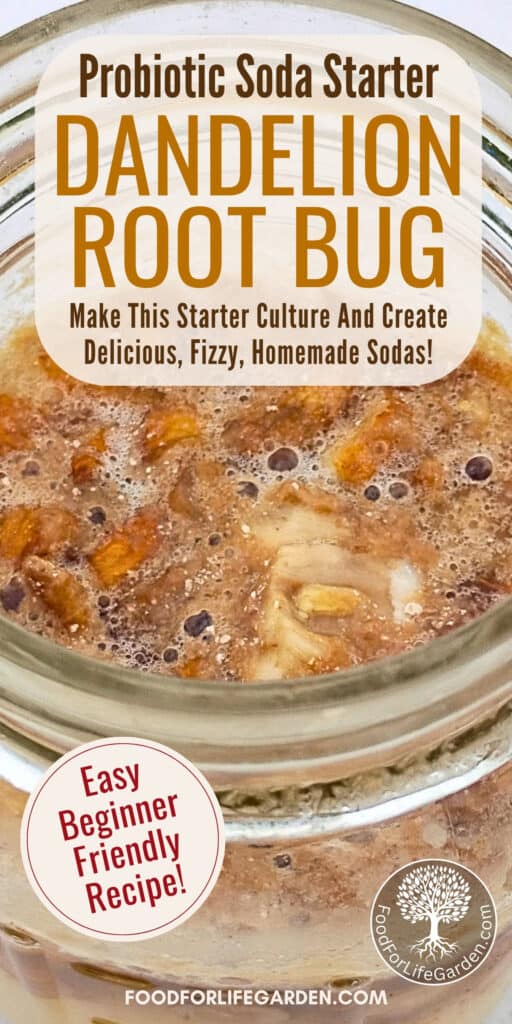

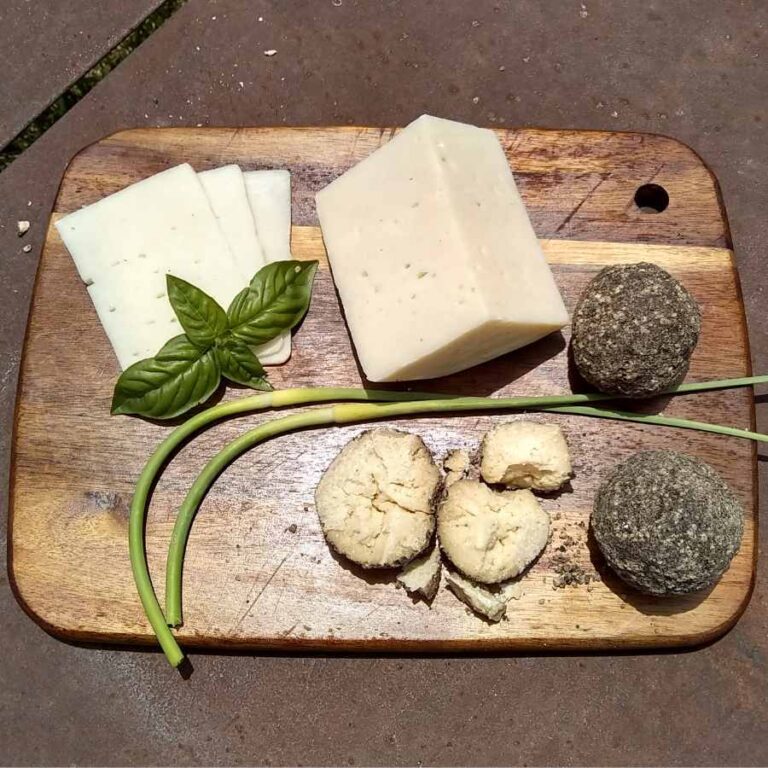
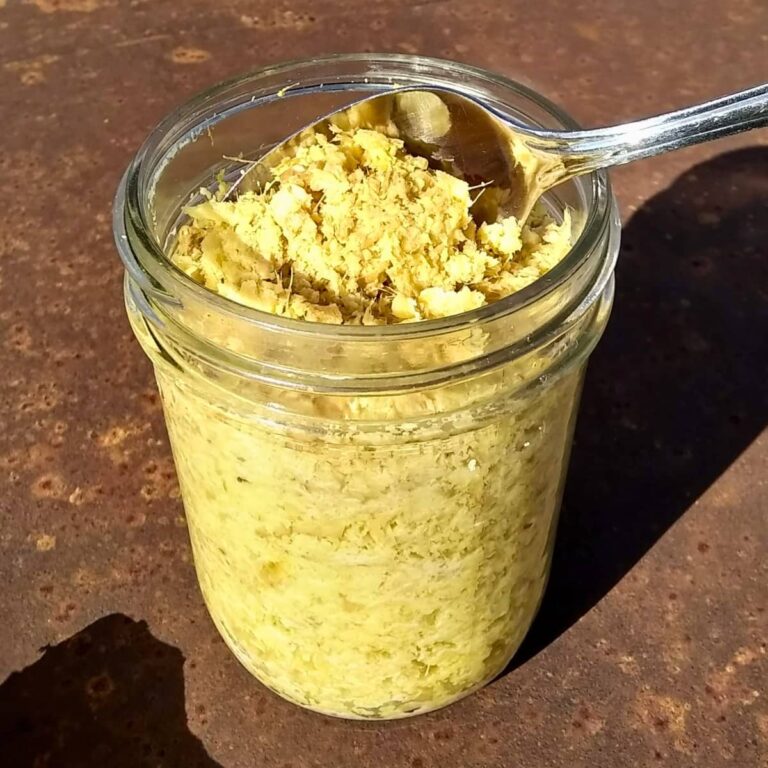

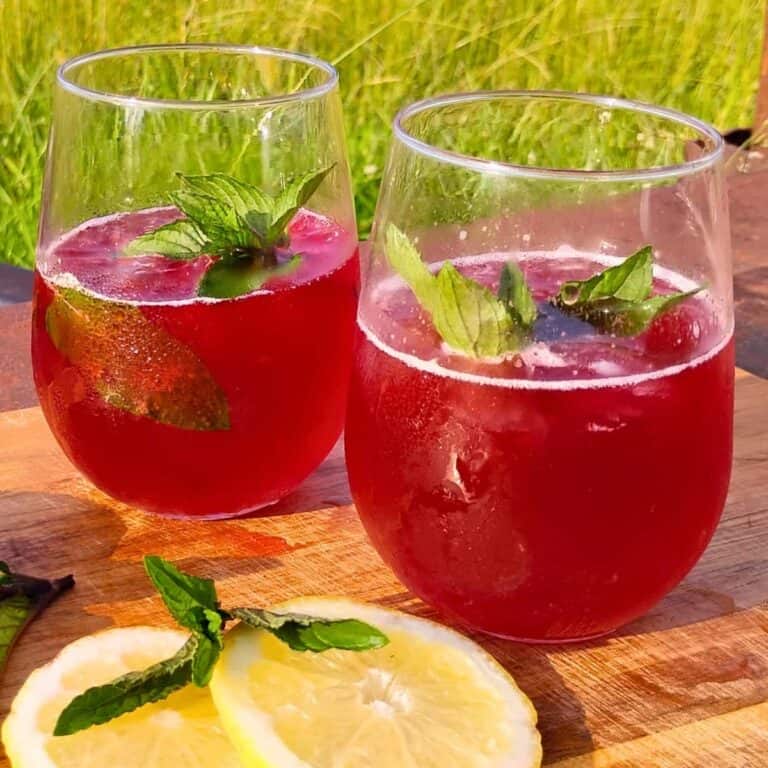
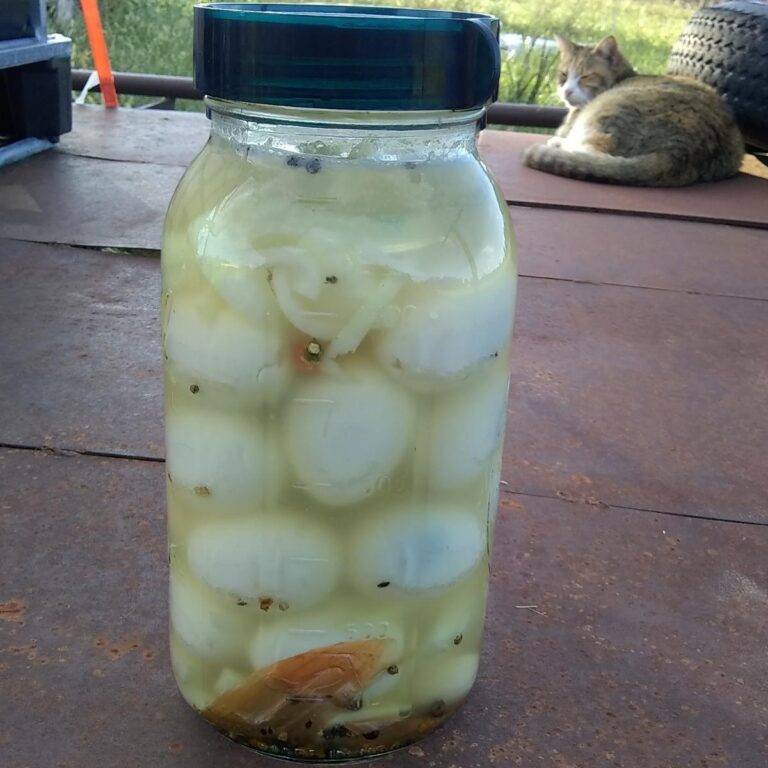
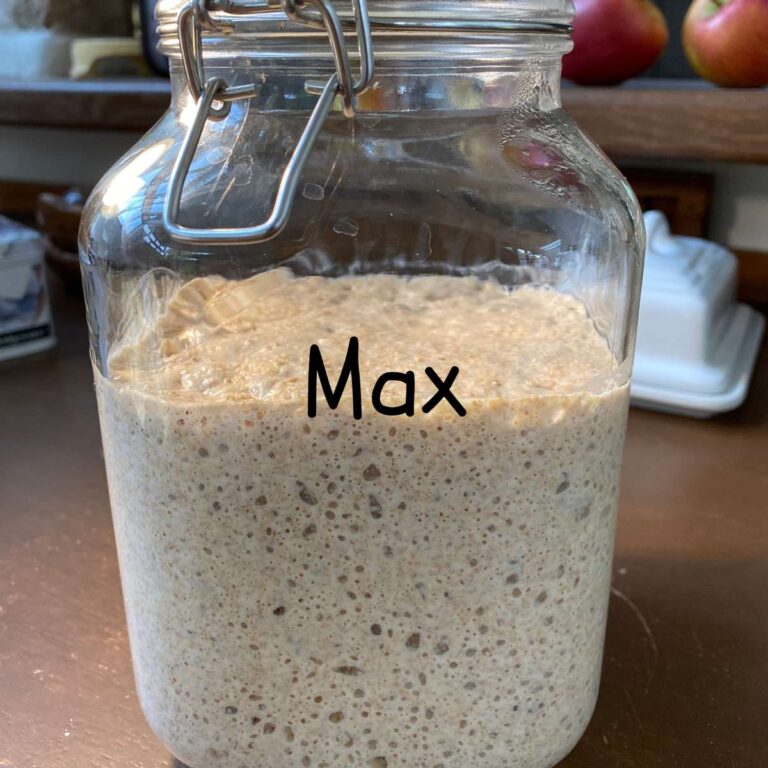
Yay, I was waiting for this recipe!! I’m gonna try it because I have plenty of weeds lol Thanks so much for sharing this great idea 🙂
Haha, gotta love those weeds! They are inspiring, lol. Have fun making it!
This is so cool! I’ve never heard of a dandelion bug soda starter, can’t wait to try this wild fermentation method!
Glad you like this! Hope you can try it and I’m sure you’ll love it!
I love how you always have soooooo much to share about all these interesting topics!
I’m telling my husband to try to mix up his coffee beans too before grinding haha
Haha, let me know what he thinks, lol. I love my weedy coffee!
This is so fun, I can’t wait to try this out with my kids!
That’s awesome! I think they will have fun with it!
I love it here. I learn something new every time I visit your website. I didn’t even know you could make fizzy drinks from dandelion root. I’ve only ever heard of it being drank as a tea. So cool! This would be fun to make with my kids! I bet they’d like the fizzy lemonade. Thanks for sharing! 🙂
It’s super tasty and I think it would be a really fun project for kids, to watch the starter culture come to live and use it to make fizzy lemonade. Thanks so much for your comment!😊